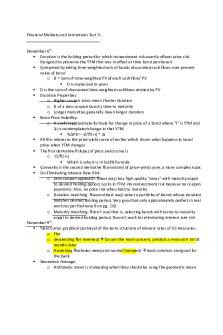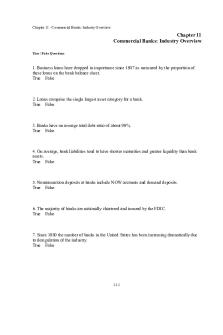Financial markets Test 3 PDF

| Title | Financial markets Test 3 |
|---|---|
| Author | Madison Jordan |
| Course | Financial Institutions Markets |
| Institution | University of Georgia |
| Pages | 13 |
| File Size | 203 KB |
| File Type | |
| Total Downloads | 63 |
| Total Views | 149 |
Summary
This document contains all of the notes for test 3. Each date header is the start of a new deck of slides....
Description
Financial Markets and Institutions Test 3:
November 6th: Duration is the holding period for which reinvestment risk exactly offsets price risk. Designed to preserve the YTM that was in effect at time bond purchased Computed by taking time-weighted sum of bonds discounted cash flows over present value of bond o D = Sum of time-weighted PV of each cash flow/ PV D is expressed in years D is the sum of discounted time-weighted cashflows divided by PV Duration Properties: o Higher coupon rates mean shorter duration o D of a zero-coupon bond is time to maturity o Longer maturities generally mean longer duration Bond Price Volatility: o A useful approximate formula for change in price of a bond where “I” is YTM and i is contemplated change in that YTM %PB = -D/(1+i) * i All this relates to the price-yield curve of earlier which shows what happens to bond price when YTM changes The first derivative (slope) of price yield curve is o -D/(1+i) Which is why it is in %PB formula Convexity is the second derivative (curvature) of price-yield curve, a more complex topic On Eliminating Interest Rate Risk: o Zero-coupon approach: (best way) buy high quality “zeros” with maturity equal to desired holding period. Locks in YTM. No reinvestment risk because no coupon payments. Also, no price risk when held to maturity o Duration matching: (second best way) select a portfolio of bonds whose duration matches desired holding period. Very good but only approximately perfect in real world as per footnote 8 on pg. 162 o Maturity matching: (don’t use) that is, selecting bonds with terms to maturity equal to desired holding period. Doesn’t work for eliminating interest rate risk November 9th: Yield Curve: graphical portrayal of the term structure of interest rates of US treasuries o Flat o descending (or inverted) Causes the most concern, predicts a recession 16-18 months later o Ascending (includes steep and normal humped) most common and good for the bank Geometric Average: o Arithmetic mean is misleading when they should be using the geometric mean
o Geometric Average = go to video at time 8:39 ALWAYS TRUE: Geometric average bank will lend issuer money to redeem maturing CP Geometric Average o [(1+r1)(1+r2)(1+rn)]^1/n - 1 If you fund long-term capital with short term debt o Risky because you might have to roll over the short-term debt Round up to .005% for auction process bids CDS’s denominated in: o 10 million in face value for 5 years at a time
Finding inflation using CPI BB = -2.097? Which is most likely not to be on a bank’s balance sheet? o BB bonds because they are NOT investment grade STRIPS: o How many zero coupon bonds can you make (1,900) TIPS: o What is the first coupon payment given face value and inflation Bank discount rate: o Yd = Pf-Po/pf (360/n) Find current price given asked yield (asked yield = BEY) o Po = Pf – ((Pf * N * Yd)/360)) Debenture = Unsecured bonds
TRUE/FALSE: The U-6 rate will always be less than the U-3 o FALSE Highway more likely to issue general obligation than revenue bonds o FALSE: revenue because used for projects B- and above are investment grade o FALSE The arithmetic mean is always less than the geometric mean o FALSE...
Similar Free PDFs

Financial markets Test 3
- 13 Pages

Financial-Markets Test-Bank
- 14 Pages

Chapter 3 Financial Markets
- 28 Pages

Chap011 - financial markets TB
- 26 Pages

Financial Markets and Institutions
- 35 Pages

Correction DM - Financial markets
- 19 Pages

Financial Institutes and markets
- 7 Pages

Financial Institutions and Markets
- 276 Pages

Financial Markets and Institution
- 20 Pages

Financial Markets reviewer
- 19 Pages

Financial Markets Cabrera (2020 EDITION)
- 188 Pages
Popular Institutions
- Tinajero National High School - Annex
- Politeknik Caltex Riau
- Yokohama City University
- SGT University
- University of Al-Qadisiyah
- Divine Word College of Vigan
- Techniek College Rotterdam
- Universidade de Santiago
- Universiti Teknologi MARA Cawangan Johor Kampus Pasir Gudang
- Poltekkes Kemenkes Yogyakarta
- Baguio City National High School
- Colegio san marcos
- preparatoria uno
- Centro de Bachillerato Tecnológico Industrial y de Servicios No. 107
- Dalian Maritime University
- Quang Trung Secondary School
- Colegio Tecnológico en Informática
- Corporación Regional de Educación Superior
- Grupo CEDVA
- Dar Al Uloom University
- Centro de Estudios Preuniversitarios de la Universidad Nacional de Ingeniería
- 上智大学
- Aakash International School, Nuna Majara
- San Felipe Neri Catholic School
- Kang Chiao International School - New Taipei City
- Misamis Occidental National High School
- Institución Educativa Escuela Normal Juan Ladrilleros
- Kolehiyo ng Pantukan
- Batanes State College
- Instituto Continental
- Sekolah Menengah Kejuruan Kesehatan Kaltara (Tarakan)
- Colegio de La Inmaculada Concepcion - Cebu




